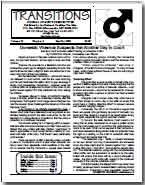
In 2009, when a significant amount of Australian data sources concluded that one in three victims of family violence are male, the One in Three Campaign was established. Senior Researcher Greg Andresen highlights the current lack of support for male victims, the difficulties faced with raising awareness of this issue and the Campaign’s efforts to overcome these challenges
To what extent are male victims denied support due to their gender in Australia?
The majority of services for victims of family violence are denied to men because of their gender. These include: court support schemes and safe rooms, crisis services and shelter/refuges, hospital and GP training and screening tools, most helplines and community awareness campaigns. While some generic (not male-specific or male-friendly) support is available to men (eg. police, Lifeline), such services are often unaware of the issues faced by male victims and unable to offer effective and appropriate help.
While individual workers within generic services might be aware of the issues, they often face workplace cultures and systems that aren’t supportive. Some generic services do not believe male victims, minimise their experiences or blame them for the abuse. The Common Risk Assessment Framework used by Mensline Australia and 1800RESPECT (the only National telephone support available for male victims) advises telephone counsellors to refer male victims of domestic violence to a male perpetrator service and their female (ex)partner to a women’s family violence service, thus assuming the male victim is actually a perpetrator and endangering his safety by alerting the female perpetrator to his actions.
Why is there a lack of public awareness regarding the existence and needs of male victims of family violence and abuse?
It was the feminist movement in the 1970s that first brought the issue of family violence to the attention of society and made it into a crime and a serious social issue. Prior to that it was often seen as ‘just a domestic’. We have been raising awareness of the issue of female victims and male perpetrators for more than 40 years. It is only in recent times that we have become aware that men too can be victims, women too can be perpetrators, and that domestic violence can affect all members of the family, as well as gay and lesbian relationships. So we are playing ‘catch up’ in terms of the social narrative around family violence.
Governments and NGOs are often reluctant to raise public awareness of the existence and needs of male victims of family violence and abuse, or provide services, because the organisations working to prevent male violence against women often downplay and deny the prevalence and experience of male victims. We saw this most recently when Queensland Premier Annastacia Palaszczuk told a community cabinet event that violence against men was something that needed to be addressed more; she was warned not to recognise male victims of domestic violence at the ‘expense of women’.
Is there a lack of sympathy for male victims? What do you think are the reasons behind this?
We as a society have a deep psychological resistance to seeing men as victims of (especially female-perpetrated) family violence. We want to believe that men are tough, strong, able to defend themselves, able to protect us, resilient, resourceful, able to look after themselves without asking for help, able to ‘take it on the chin’, to ‘man up’. Admitting that men can be victims of domestic violence threatens this deeply held and cherished view of masculinity. Therefore we say ‘he must have done something to deserve it’, or ‘he must really be a perpetrator’, or ‘why doesn’t he just leave?’
Our society also has a tendency to see gender relations as a zero-sum binary. We believe that supporting male victims is somehow taking something away from female victims; that providing services and support for men would necessarily take away services and support for women. Therefore we are reluctant to sympathise with male victims for fear of taking attention away from female victims.
How is the One in Three Campaign working to improve this awareness and what do you hope the knock-on effects will be?
We work hard to get the experiences of male victims, as well as the latest facts, stats and research, circulated in both the mainstream and social media. We lobby governments and NGOs, take part in inquiries and Royal Commissions and present at conferences. We also collaborate with researchers, NGOs and service providers to establish more services and support for male victims and their children. We hope the knock-on effects will be to reduce the incidence and impacts of family violence on Australian men, women and children, and create healthier, happier families and relationships.
What difficulties have you encountered during your work, particularly as support for men’s rights can be misinterpreted as intention to harm women’s?
The main challenge we face is the perception that advocating for male victims is somehow an attack upon female victims or upon women in general. It’s not. It never has been. We believe our society has the capacity to support all victims of family violence, whether young or old, male or female, gay or straight, rich or poor, wherever they live.
Another challenge is the ‘gendered violence’ paradigm that has existed for decades across government, NGOs and large sections of academia, where family violence has become synonymous with violence against women and the sole or main cause is ‘the patriarchy’. It is difficult for people who are invested in this paradigm to accept the need for services and support for male victims. When a longstanding paradigm is challenged in any field, people understandably feel threatened because they have invested so much time, money, effort and emotion into working under that model. The family violence sector is no different.
The One in Three Campaign has consistently argued since its foundation in 2009 that female victims of family violence need all the help they can get. In fact they are in dire need of extra services. We simply argue that men need services as well. Standing up for male victims is not an attack upon female victims or upon women in general.
In your latest report, you mention that the Campaign was partially established based on increasing evidence that a significant proportion of victims of family violence and abuse are male. Could you provide a little more insight into this?
When the Campaign was established in 2009, all the major recent Australian data sources on family violence concluded that around one-third of victims were male: the Australian Bureau of Statistics Personal Safety Survey, the South Australian Interpersonal Violence and Abuse Survey, the National Crime Prevention’s Young People and Domestic Violence survey, NSW Bureau of Crime Statistics and Research reports, the Queensland Crime and Misconduct Commission, the Australian Institute of Criminology’s National Homicide Monitoring Program, and data from the Australian Institute of Family Studies.
Yet the then Federal Labor Government ignored this data and instead launched the National Plan to Reduce Violence against Women and their Children 2010-2022, which completely ignored the experiences of male victims of family violence and their children. We therefore felt it our social duty to step in and advocate to create the support that the Government was failing to provide.
Do you intend to extend the Campaign to other countries where similar problems exist for male victims of domestic violence?
We are a small group of male and female professionals – academics, researchers, social workers, psychologists, counsellors, lawyers, health promotion workers, trainers and survivor/advocates. We work on a voluntary basis with no funding. If and when our resources permit, we would like to expand the campaign to other countries – New Zealand would be a natural first step. However at present our resources are fully taken up with our work in Australia.
What have been some of the Campaign’s key successes so far?
Our recent achievements include working on the production of a poster outlining the limited services available to male victims of family violence in Western Sydney, and working alongside the Police, Women’s Domestic Violence Court Advocacy Service and Victim and Witnesses of Crime Court Support on the Insight trial court support service for male victims of violence at the Downing Centre and Parramatta courthouses. We also saw Mensline Australia start to provide online resources for male victims of family violence – both straight and gay – and saw the Start Safely housing subsidy opened up to male victims. None of these activities has had any negative impact whatsoever upon female victims of family violence or women in general. All of them have improved the lives of men who have experienced or are experiencing family violence. Our society can support all victims – we really can.


